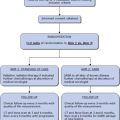Lung cancer has been transformed from a rare disease into a global problem and public health issue. The etiologic factors of lung cancer become more complex along with industrialization, urbanization, and environmental pollution around the world. Currently, the control of lung cancer has attracted worldwide attention. Studies on the epidemiologic characteristics of lung cancer and its relative risk factors have played an important role in the tertiary prevention of lung cancer and in exploring new ways of diagnosis and treatment. This article reviews the current evolution of the epidemiology of lung cancer.
Key points
- •
Lung cancer is the most frequent malignant tumor with the highest mortality around the world.
- •
Recent epidemic studies found that tobacco use, radon exposure, indoor and outdoor air pollution, relative harmful occupational exposure, hereditary susceptibility, radiation exposure, and unbalanced diet are responsible for the increase in lung cancer incidence.
- •
These findings can assist us in preventing lung cancer from the etiologic level. Effective and practical public health policy such as tobacco use restriction law, air pollution control, and antismoking education of teenagers should be established to decrease the lung cancer incidence.
Epidemiologic characteristics
Incidence and Mortality
Globally, lung cancer is the most common cancer and the leading cause of cancer death in men and is the third most common cancer (after breast and colorectal cancers) and the second leading cause of cancer death (after breast cancer) in women. About 1.8 million new cases of lung cancer were diagnosed in 2012, which accounted for 12.9% of the world’s total cancer incidence. The worldwide lung cancer mortality rate amounted to 1.59 million deaths in 2012, accounting for 19.4% of the total cancer deaths.
Smoking is a known major risk factor for lung cancer, so lung cancer epidemiologic trends, and its variations, reflect the past trends of cigarette smoking to a great extent. In the United States, most states drew up legislation for smoking restrictions in public areas about 20 years ago and have continually promoted the awareness of smoking hazards to their residents. Many states have passed the peak of the tobacco-related epidemic; therefore, both the incidence and mortality rates of lung cancer in these areas are decreasing.
Over the last several decades, the incidence of adenocarcinoma of the lung has increased more rapidly than that of squamous cell carcinoma in men and especially in women. Adenocarcinoma has become the most common histologic cancer type diagnosed around the world since 2004, according to statistics from the World Health Organization. This trend probably is associated with the change of historic pattern of tobacco use or the smoke of modern filtered cigarettes. Sex differences in lung cancer mortality patterns also reflect historical differences between men and women in the increase and reduction of cigarette smoking over the last 50 years.
In developing countries such as China, not only the incidence but also the mortality rate of lung cancer has been increasing rapidly; incidence was ranked first in men and second in women; however, the death rate ranked first in both men and women from the annual report of the China national cancer registration. The adenocarcinoma subtype has become the major pathologic type not only in the nonsmoking population but also in the smoking population. The smoking pattern, therefore, may be changing but may only be a partial cause of the pathologic evolution of lung cancer. Lung cancer incidence may be related to air pollution caused by rapid and immature industrialization and continual increased use of automobiles in cities.
The global geographic distribution of lung cancer shows marked regional variation. In men, the highest incidence rates are observed in Central and Eastern Europe (53.5 per 100,000) and Eastern Asia (50.4 per 100,000). Notably low incidence rates are observed in Middle and Western Africa (2.0 and 1.7 per 100,000, respectively). In women, the incidence rates are generally lower, and the geographic pattern is a little different, mainly reflecting different historical exposure to tobacco smoking. Thus, the highest estimated rates are in Northern America (33.8) and Northern Europe (23.7) with a relatively high rate in Eastern Asia (19.2) and the lowest rates again in Western and Middle Africa (1.1 and 0.8, respectively). For lung cancer mortality, because of its high fatality (the overall ratio of mortality to incidence is 0.87) and the relative lack of variability in survival in different world regions, the geographic patterns in mortality closely follow those in incidence.
Incidence and mortality rates of lung cancer also differ by ethnicity. In 2012, black Americans had the highest incidence rates of 62 per 100,000 and the highest mortality rates of 48.4 per 100,000, whereas Hispanics had the lowest rate of 28 per 100,000 in incidence and the lowest rate of 19.4 per 100,000 in mortality.
Survival
The incidence and mortality rates of lung cancer tend to mirror one another because most patients with lung cancer eventually die of it. Despite the new diagnostic and genetic technologies that are now available and the many advances in surgical technique and biologic treatment, such as targeted treatment and immunotherapy, the overall 5-year survival rate (2005–2011) of lung cancer in the United States is still dismal (17.4%). The global situation is also worse than before. Most lung cancer is discovered at an advanced stage, and the fact that only 15% of lung cancers are discovered in early stages may be responsible for the dismal prognosis. Therefore, early diagnosis by screening high-risk populations using low-dose computed tomography scan and effective biomarkers may improve the survival of lung cancer patients.
Epidemiologic characteristics
Incidence and Mortality
Globally, lung cancer is the most common cancer and the leading cause of cancer death in men and is the third most common cancer (after breast and colorectal cancers) and the second leading cause of cancer death (after breast cancer) in women. About 1.8 million new cases of lung cancer were diagnosed in 2012, which accounted for 12.9% of the world’s total cancer incidence. The worldwide lung cancer mortality rate amounted to 1.59 million deaths in 2012, accounting for 19.4% of the total cancer deaths.
Smoking is a known major risk factor for lung cancer, so lung cancer epidemiologic trends, and its variations, reflect the past trends of cigarette smoking to a great extent. In the United States, most states drew up legislation for smoking restrictions in public areas about 20 years ago and have continually promoted the awareness of smoking hazards to their residents. Many states have passed the peak of the tobacco-related epidemic; therefore, both the incidence and mortality rates of lung cancer in these areas are decreasing.
Over the last several decades, the incidence of adenocarcinoma of the lung has increased more rapidly than that of squamous cell carcinoma in men and especially in women. Adenocarcinoma has become the most common histologic cancer type diagnosed around the world since 2004, according to statistics from the World Health Organization. This trend probably is associated with the change of historic pattern of tobacco use or the smoke of modern filtered cigarettes. Sex differences in lung cancer mortality patterns also reflect historical differences between men and women in the increase and reduction of cigarette smoking over the last 50 years.
In developing countries such as China, not only the incidence but also the mortality rate of lung cancer has been increasing rapidly; incidence was ranked first in men and second in women; however, the death rate ranked first in both men and women from the annual report of the China national cancer registration. The adenocarcinoma subtype has become the major pathologic type not only in the nonsmoking population but also in the smoking population. The smoking pattern, therefore, may be changing but may only be a partial cause of the pathologic evolution of lung cancer. Lung cancer incidence may be related to air pollution caused by rapid and immature industrialization and continual increased use of automobiles in cities.
The global geographic distribution of lung cancer shows marked regional variation. In men, the highest incidence rates are observed in Central and Eastern Europe (53.5 per 100,000) and Eastern Asia (50.4 per 100,000). Notably low incidence rates are observed in Middle and Western Africa (2.0 and 1.7 per 100,000, respectively). In women, the incidence rates are generally lower, and the geographic pattern is a little different, mainly reflecting different historical exposure to tobacco smoking. Thus, the highest estimated rates are in Northern America (33.8) and Northern Europe (23.7) with a relatively high rate in Eastern Asia (19.2) and the lowest rates again in Western and Middle Africa (1.1 and 0.8, respectively). For lung cancer mortality, because of its high fatality (the overall ratio of mortality to incidence is 0.87) and the relative lack of variability in survival in different world regions, the geographic patterns in mortality closely follow those in incidence.
Incidence and mortality rates of lung cancer also differ by ethnicity. In 2012, black Americans had the highest incidence rates of 62 per 100,000 and the highest mortality rates of 48.4 per 100,000, whereas Hispanics had the lowest rate of 28 per 100,000 in incidence and the lowest rate of 19.4 per 100,000 in mortality.
Survival
The incidence and mortality rates of lung cancer tend to mirror one another because most patients with lung cancer eventually die of it. Despite the new diagnostic and genetic technologies that are now available and the many advances in surgical technique and biologic treatment, such as targeted treatment and immunotherapy, the overall 5-year survival rate (2005–2011) of lung cancer in the United States is still dismal (17.4%). The global situation is also worse than before. Most lung cancer is discovered at an advanced stage, and the fact that only 15% of lung cancers are discovered in early stages may be responsible for the dismal prognosis. Therefore, early diagnosis by screening high-risk populations using low-dose computed tomography scan and effective biomarkers may improve the survival of lung cancer patients.
Risk factors
Tobacco
The prevalence of lung cancer has been confirmed as a consequence of the widespread addiction to cigarettes throughout the world. Many developed countries have now passed the peak of the tobacco-related epidemic, and their lung cancer incidence and mortality rates are decreasing.
As a single etiologic agent, tobacco is by far the most important risk factor in the development of lung cancer. It is estimated that around the world, 80% of lung cancer cases in men and 50% in women each year are caused by smoking. The abundance of evidence of dose-response relationship and biological plausibility overwhelmingly supports the existence of a causal relationship between smoking and lung cancer. The same relationship exists between passive smoking (so-called second-hand smoke) and lung cancer.
The risk for lung cancer among cigarette smokers increases along with long duration of smoking; some studies showed stronger effect of smoking duration than smoking amount per day. Young smokers have a greater likelihood of becoming heavier smokers and maintain their smoking habit, and the risk of suffering lung cancer by long and heavy smoking remarkably increases. Therefore, antismoking campaigns aimed at teenagers are obviously necessary and effective in reducing lung cancer risk. Meanwhile, cigarette smokers can decrease their risk of lung cancer development by quitting smoking at any age.
Recent research finds that smoking filtered cigarettes can decrease tar absorption but can increase intake of nitrosamines. It may be one of the important factors resulting in the pathologic change from squamous cell carcinoma into adenocarcinoma.
Air Pollution
Outdoor or indoor air pollution is a significant environmental risk factor for lung cancer; long-term exposure to polluted air caused by factories and automobiles, cooking fumes, or formaldehyde from indoor decoration definitely increases the risk of lung cancer. Early ecologic studies found that more than 50% of lung cancer occurred in urban areas, which is most probably more from polluted air from industrial sources and vehicle exhaust than in rural areas. A series of case-control and cohort studies found a notable association between lung cancer and air pollution with adequate adjustment for tobacco use and other potential risk factors.
Outdoor air pollution mostly comes from vehicle exhaust, heating systems, and industrial burning waste. Carcinogens that are generated by combustion of fossil fuels include polycyclic aromatic hydrocarbons and metals such as arsenic, nickel, and chromium. A recent study also indicates that mono-nitrogen oxides nitric oxide and nitrogen dioxide are the main carcinogenic agents from vehicle exhaust. Study results from Liaw and colleagues showed that there was a dose-response relationship between gaseous nitric oxide concentrations and lung adenocarcinoma. A study by Yu and colleagues found the mutation spectrum of air pollution–related lung cancers and provided evidence of an air pollution exposure–genomic mutation relationship on a large scale.
Indoor air pollution includes cooking fumes, formaldehyde and benzene from decorative and building materials, and environmental tobacco smoke. According to the Ministry of Health of China, women and children are more likely to be the victims of indoor air pollution, as they spend most of their time indoors. Epidemiologic studies found that lung cancer incidence increases with the number of meals cooked per day; exposure to fumes from cooking oils is an important risk factor for lung cancer in rural China. From the research carried out in Xuanwei County, China over several decades, household coal use is the major source of household air pollution; the studies also identified that household coal fuel use contributed to the high mortality rate of lung cancer in this region.
Radon
Radon is an inert gas that is produced naturally from radium in the decay series of uranium. Indoor radon concentrations usually come from the soil and building materials. Radon is likely the second most common cause of lung cancer after smoking; about 20,000 lung cancer deaths each year in the United States are radon related. Three cohort studies conducted in the Europe, North America, and China, found that chronic exposure to radon contributes to the occurrence of lung cancer. The relative risk of lung cancer in the observed radon concentration greater than per 100 Bq/m 3 was 8% (95 confidence interval [CI], 3%–6%), 11% (95 CI, 0%–28%), and 13% (95 CI, 1%–36%), respectively.
Occupational Exposure
The International Agency for Research on Cancer has identified 12 occupational exposure factors as being carcinogenic to the human lung (aluminum production, arsenic, asbestos, bis-chloromethyl ether, beryllium, cadmium, hexavalent chromium, coke and coal gasification fumes, crystalline silica, nickel, radon, and soot). Asbestos is a well-established occupational carcinogen and refers to several forms of fibrous, naturally occurring silicate minerals; exposure to asbestos at high levels can cause lung cancer and mesothelioma. From cohort studies on cancer mortality among workers exposed to asbestos in China, a significantly elevated meta–standard mortality ratio for lung cancer is 4.54, with 95% CI of 2.49 to 8.24. Concurrent smoking and asbestos exposure are synergistic and result in increased cancer incidence.
Hereditary Susceptibility
Most studies indicate that more than 80% of lung cancer occurrence is associated with the habit of smoking, but less than 20% of smokers will have lung cancer, which suggests that lung cancer occurrence probably possesses genetic susceptibility. Forty years ago, Tokuhata and Lilienfeld provided the first epidemiologic evidence of familial aggregation of lung cancer. Studies find that the lung cancer risk of the probands’ first-degree relatives was 1.88 times higher than that of the controls’ families. Several novel lung cancer susceptibility genes have been identified by recent large-scale genomewide association studies, including those on chromosomes 5p15.33, 6p21,15q24 to 25.1,6q23 to 25, and 13q31.3. The risk of disease can be conceptualized as reflecting the joint consequences of the interrelationship between exposure to etiologic agents and the individual susceptibility to these agents. For lung cancer, some relevance of gene environment have been identified. For example, the 15q25 region contains 3 nicotine acetylcholine receptor subunit genes, and nicotine addiction is indirectly associated with lung cancer risk by increase of tobacco carcinogen intake. Meanwhile, this gene is also identified as a risk factor for several smoking-related diseases, such as chronic obstructive pulmonary disease. Furthermore, there are still several other molecular pathways for the development of lung adenocarcinomas, such as the 5p15.33, but their mechanism are still unclear.
Radiation
Two types of radiation are relevant to lung cancer: low linear energy transfer radiation (eg, x-rays, gamma rays) and high linear energy transfer radiation (eg, neutrons, radon). Epidemiologic studies find that exposure to high doses of radiation is associated with lung cancer. However, whether low-dose radiation is relevant to lung cancer is still unclear.
Diet
After decades of research on diet and lung cancer, many specific micronutrients thought to have anticarcinogenic activity, such as retinol and beta-carotene, have been found. Most of the micronutrients are common in fruits and vegetables. Intake of more fresh fruits and vegetables may decrease the risk of lung cancer.
Others
There are still other risk factors for lung cancer, such as human immunodeficiency virus infection and estrogen levels; the question of whether these factors are real risk factors for lung cancer has been controversial, and further studies are needed to evaluate this conclusively.
Stay updated, free articles. Join our Telegram channel

Full access? Get Clinical Tree







